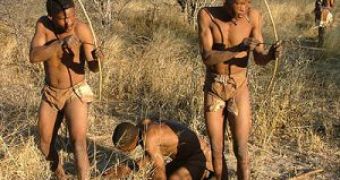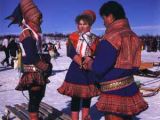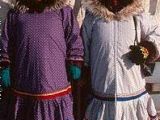Anthropologists have noticed that most primitive tribes name themselves by the word that in their name means "people".
But many others are known by the names other people gave to them. Sometimes, these names are not in conformity with the reality, in other situations they are.
Let's see the roots of some names.
Bushmen, an ancestral African race (they are considered the oldest living human race) live today restricted only in the Namib and Kalahari deserts (Meridional Africa). Just one thousand years ago, they still populated most of southern/eastern Africa, but the migration of the Bantu tribes (originating from southern Nigeria) restricted them to a strip of land in southern Africa.
When the Boers started their colonization of South Africa during the XVIIIth century, these short people retreated to the deserts, in the "bush area" (hence their name). They call themselves "San", which means "people" in their language.
The Eskimos represent the Earth's most adapted population to the cold climate. They live from the extreme point of eastern Siberia (Chukotka peninsula) to Greenland (through Northern Alaska and Canada). Their name comes from the languages of the Algonquian Indians, "wiyaskimowok", which means "eaters of raw meat". The Eskimos call themselves "Inuit", which means "people" in their language.
The Lapps are the Europe's northernmost population, inhabiting the northern Scandinavian Peninsula, in northern Norway, Sweden, Finland and neighboring Russia.
This name is used since the XIIIth century and comes from the Finish word "loppu" that means edge, extremity. Lapps originated in the area of Altai mountains (in southern Siberia), just as all Finno-Ugric People (like Finns, Estonians, Hungarians).
As the Finns name their country Suomi, Lapps call themselves Sami and their territory Sapmi.
Maori, the indigenous people of New Zealand, that originated in Polynesia, trace their name in the same word of their language, meaning "human".
The indigenous people of North America were called Redskins by the Europeans.
The name traces its roots in Columbus' voyages, the sailor met in the Caribbean with an odd red color of the skin. This was due to the ochre they used to slosh their face and body.
This misconception was then applied to all indigenous of Americas, even if the habit is not employed by the natives of North America. In change, some tribes in South America still practice it. Later, the native Americans were named Amerindians, a proper name.
Pygmies represent an ancient race that once was distributed from Africa to southern Asia, but today they are encountered only in scattered locations, in central Africa (Congo basin), Malaya, Andaman, Philippines, New Guinea, Flores and other islands of Indonesia. Their height is 1.3 to 1.5 m (4.3 to 5 ft). The name comes from Old Greek "pygmaeus", meaning ell.
They prefer to be named by their own ethnical names.
Most islands of the Central Pacific form Polynesia, and their inhabitants are named Polynesians. Polynesia means "many islands" in Old Greek. Near Australia, the Pacific archipelagos form the so called Melanesia, inhabited by "Melanesians". This means "black islands", name given because the Melanesians have very dark skin.
The Zulu are an ethnic group living in southeastern South Africa. Their tradition says that Zulu ("The son of the sky") was the leader of a small clan from the Ngoni tribe (ancestors of the Zulu) which after his father's death, in the XVIIth century, left the natal place on Transval (eastern South Africa). At the beginning of the XIXth century, king Chaka extended this denomination over all the tribes under his power, being named since then Zulus ("The sons of the sky').

 14 DAY TRIAL //
14 DAY TRIAL // 

